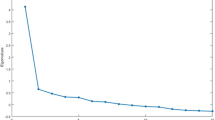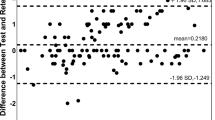Abstract
Purpose
Evaluation of the psychometric properties of a cross-culturally adapted questionnaire, the Core Outcome Measurement Index for neck pain (COMI-neck).
Methods
The COMI-neck was cross-culturally adapted for the Italian language using established procedures. The following psychometric properties of the instrument were then assessed in patients with chronic neck pain undergoing rehabilitation: test–retest reliability (intraclass correlation coefficient, ICC); construct validity by comparing COMI-neck with the Neck Pain and Disability Scale, a numerical pain rating scale, and the EuroQol-Five Dimension (Pearson’s correlations); and responsiveness by means of Standardized Response Mean (SRM), unpaired t tests, and Receiver Operating Characteristics (ROC) curves.
Results
The questionnaire was completed by 103 subjects. The COMI-neck summary score displayed no relevant floor or ceiling effects. Test–retest reliability was excellent (ICC = 0.87). With one exception (symptom-specific well-being), the individual COMI items and the COMI summary score correlated to the expected extent with the scores of the reference questionnaires (r = 0.40–0.80). The mean change scores for the Italian COMI-neck differed significantly between patients with a good global outcome and those with a poor outcome (p = 0.002); SRM for the good outcome group was 1.23, and for the poor outcome group 0.40. ROC analysis revealed an area under the curve of 0.73 (95 % CI: 0.62–0.85).
Conclusions
This study provides evidence that the Italian version of the COMI-neck is a valid and responsive questionnaire in the population of patients examined. Its use is recommended for clinical and research purposes.
Similar content being viewed by others

References
Cotè P, van der Velde G, Cassidy D, Carroll LJ, Hogg-Johnson S, Holm LW et al (2008) The burden and determinants of neck pain in workers. The Bone and Joint Decade 2000–2010 Task Force on Neck Pain and Its Associated Disorders. Spine (Phila Pa 1976) 33(Suppl):S60–S74
Hogg-Johnson S, van der Velde G, Carroll LJ, Holm LW, Cassidy JD, Guzman J et al (2008) The burden and determinants of neck pain in the general population. The Bone and Joint Decade 2000–2010 Task Force on Neck Pain and Its Associated Disorders. Spine (Phila Pa 1976) 33(Suppl):S39–S51
Deyo R, Battie M, Beurskens A, Bombardier C, Croft P, Koes B, Malmivaara A, Roland M, Von Korff M, Waddell G (1998) Outcome measures for low back pain research. A proposal for standardized use. Spine (Phila Pa 1976) 23:2003–2013
Mannion AF, Porchet F, Kleinstuck FS, Lattig F, Jeszenszky D, Bartanusz V, Dvorak J, Grob D (2009) The quality of spine surgery from the patient’s perspective. Part 1: the Core Outcome Measures Index in clinical practice. Eur Spine J 18(Suppl 3):367–373
Mannion A, Elfering A, Staerkle R, Junge A, Grob D, Semmer N, Jacobshagen N, Dvorak J, Boos N (2005) Outcome assessment in low back pain: how low can you go? Eur Spine J 14:1014–1026
Ferrer M, Pellisé F, Escudero O, Alvarez L, Pont A, Alonso J, Deyo R (2006) Validation of a minimum outcome core set in the evaluation of patients with back pain. Spine (Phila Pa 1976) 31:1372–1379
Zweig T, Mannion AF, Grob D, Melloh M, Munting E, Tuschel A, Aebi M, Roder C (2009) How to Tango: a manual for implementing Spine Tango. Eur Spine J 18(Suppl 3):312–320
White P, Lewith G, Prescott P (2004) The core outcomes for neck pain: validation of a new outcome measure. Spine (Phila Pa 1976) 29:1923–1930
Fankhauser CD, Mutter U, Aghayev E, Mannion AF (2012) Validity and responsiveness of the Core Outcome Measures Index (COMI) for the neck. Eur Spine J 21(1):101–114
Mannion AF, Boneschi M, Teli M, Luca A, Zaina F, Negrini S, Schulz PJ (2012) Reliability and validity of the cross-culturally adapted Italian version of the Core Outcome Measures Index. Eur Spine J 21(Suppl 6):S737–S749
Beaton DE, Bombardier C, Guillemin F et al (2000) Guidelines for the process of cross-cultural adaptation of self-report measures. Spine (Phila Pa 1976) 25:3186–3191
Kamper SJ, Ostelo RWJG, Knol DL, Maher CG, de Vet HCW, Hancock MJ (2010) Global Perceived Effect scales provided reliable assessments of health transition in people with musculoskeletal disorders, but ratings are strongly influenced by current status. J Clin Epidemiol 63:760–766
Wheeler AH, Goolkasian P, Baird AC, Darden BV 2nd (1999) Development of the Neck Pain and Disability Scale: item analysis, face, and criterion-related validity. Spine (Phila Pa 1976) 24(13):1290–1294
Monticone M, Baiardi P, Nido N, Righini C, Tomba A, Giovanazzi E (2008) Development of the Italian version of the Neck Pain and Disability Scale, NPDS-I. Spine (Phila Pa 1976) 33(13):E429–E434
Brooks R (2003) The measurement and valuation of health status using EQ-5D: a European perspective evidence from EuroQol BIOMED research programme. Kluwer, Dordrecht
Savoia E, Fantini MP, Pandolfi PP, Dallolio L, Collina N (2006) Assessing the construct validity of the Italian version of the EQ-5D: preliminary results from a cross-sectional study in North Italy. Health Qual Life Outcomes 4:47
Prieto L, Sacristan JA (2004) What is the value of social values? The uselessness of assessing health-related quality of life through preference measures. BMC Med Res Methodol 4:10
Huskinson EC (1974) Measurement of pain. Lancet 2:1127–1131
Terwee C, Bot S, de Boer M, van der Windt D, Knol D, Dekker J, Bouter L, de Vet H (2007) Quality criteria were proposed for measurement properties of health status questionnaires. J Clin Epidemiol 60:34–42
Revicki D, Hay RD, Cella D, Sloan J (2006) Recommended methods for determining responsiveness and minimally important differences for patient-reported outcomes. J Clin Epidemiol 61:102–109
Husted JA, Cook RJ, Farewell VT, Gladman DD (2000) Methods for assessing responsiveness: a critical review and recommendations. J Clin Epidemiol 53:459–468
Cohen J (1988) Statistical power analysis for the behavioural sciences. Lawrence Earlbaum Associates, Hillsdale
Kazis L, Anderson J, Meenan R (1989) Effect sizes for interpreting changes in health status. Med Care 27:S178–S189
Beaton DE, Bombardier C, Katz JN, Wright JG (2001) A taxonomy for responsiveness. J Clin Epidemiol 54:1204–1217
Zweig M, Campbell G (1993) Receiver-operating characteristic (ROC) plots: a fundamental evaluation tool in clinical medicine. Clin Chem 39:561–577
Hyland M (2003) A brief guide to the selection of quality of life instrument. Health Qual Life Outcomes 1:24
Beurskens AJHM, de Vet HCW, Koke AJA (1996) Responsiveness of functional status in low back pain: a comparison of different instruments. Pain 65:71–76
Acknowledgments
The authors would like to thank all the physiotherapists and the patients who took part in the study.
Author information
Authors and Affiliations
Corresponding author
Additional information
IRB approval
Our Institutional Review Board approved the research and the study was conducted in conformity with ethical and humane principles of research.
Appendices
Appendix 1: English version of the COMI-neck
Neck problems can lead to neck pain and/or pain in the arm/shoulder region, as well as to sensory disturbances such as tingling, ‘pins and needles’, or numbness in any of these regions.
For the following 2 questions (1a and 1b), we would like you to indicate the severity of your pain, by marking a cross on the line from 0 to 10 (where “0” = no pain, “10” = the worst pain you can imagine).
Appendix 2: Italian version of the COMI-neck
I problemi al collo possono portare a dolori alla zona cervicale e/o alle spalle ed alle braccia, oltre che a disturbi come formicolio, puntura di aghi e spilli o riduzione della sensibilità in una di queste regioni.
Nelle prossime 2 domande (1a e 1b) indichi l’intensità del suo dolore, segnando una croce sulla linea da 0 a 10 (dove 0 = nessun dolore, 10 = il dolore più forte che lei possa immaginare).

Rights and permissions
About this article
Cite this article
Monticone, M., Ferrante, S., Maggioni, S. et al. Reliability, validity and responsiveness of the cross-culturally adapted Italian version of the core outcome measures index (COMI) for the neck. Eur Spine J 23, 863–872 (2014). https://doi.org/10.1007/s00586-013-3092-y
Received:
Revised:
Accepted:
Published:
Issue Date:
DOI: https://doi.org/10.1007/s00586-013-3092-y



